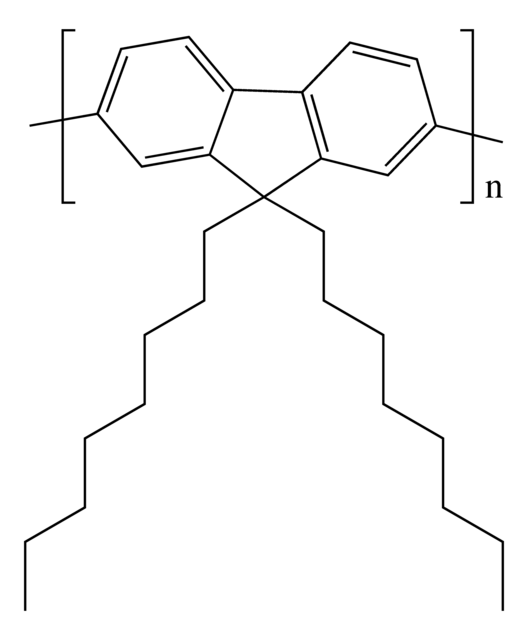594199
Poly[(p-phenylenevinylene)-alt-(2-methoxy-5-(2-ethylhexyloxy)-p-phenylenevinylene)]
Sign Into View Organizational & Contract Pricing
All Photos(1)
About This Item
Linear Formula:
(C25H32O2)n
CAS Number:
MDL number:
UNSPSC Code:
12352103
NACRES:
NA.23
Recommended Products
form
solid
solubility
chloroform: soluble
organic solvents: soluble
fluorescence
λex 451 nm; λem 517 nm in chloroform
Related Categories
General description
Poly[(p-phenylenevinylene)-alt-(2-methoxy-5-(2-ethylhexyloxy)-p-phenylenevinylene)] (p-PMEH-PPV) is a conducting polymer that can be used as an active material in the development of optoelectronic devices. It forms a conjugated-nonconjugated multiblock copolymer which can be used as an electroluminescent polymeric material. It can be potentially operated at low voltages with quick responsive and defined displays.
Application
p-PMEH-PPV can be used as a blue EL polymer for the fabrication of semiconductor devices such as organic light emitting diodes (OLEDs), thin film transistors (TFTs), photovoltaic cells and chemical sensors.
Features and Benefits
Light emitting semiconjugated alternating copolymer.
Light emission blue shifted relative to that for MEH-PPV by introduction of unsubstituted phenylene units with para linkage in the polymer main chain, shortening the effective conjugation length of the polymer.
Storage Class Code
11 - Combustible Solids
WGK
WGK 3
Flash Point(F)
Not applicable
Flash Point(C)
Not applicable
Personal Protective Equipment
dust mask type N95 (US), Eyeshields, Gloves
Choose from one of the most recent versions:
Certificates of Analysis (COA)
Lot/Batch Number
Don't see the Right Version?
If you require a particular version, you can look up a specific certificate by the Lot or Batch number.
Already Own This Product?
Find documentation for the products that you have recently purchased in the Document Library.
Blue electroluminescent polymers: control of conjugation length by kink linkages and substituents in the poly (p-phenylenevinylene)-related copolymers
Ahn T, et al.
Macromolecules, 32(10), 3279-3285 (1999)
High-efficiency poly (p-phenylenevinylene)-based copolymers containing an oxadiazole pendant group for light-emitting diodes
Jin S, et al.
Journal of the American Chemical Society, 126(8), 2474-2480 (2004)
A molecular photosensor based on photoswitching of charge carrier mobility
Macromolecular Symposia, 247(1), 318-325 (2007)
Synthesis and photo-induced charge separation of confined conjugation length phenylene vinylene-based polymers
Tan TAT, et al.
Polym. Chem., 4(20), 5305-5309 (2013)
Our team of scientists has experience in all areas of research including Life Science, Material Science, Chemical Synthesis, Chromatography, Analytical and many others.
Contact Technical Service![Poly[2-methoxy-5-(2-ethylhexyloxy)-1,4-phenylenevinylene] average Mn 40,000-70,000](/deepweb/assets/sigmaaldrich/product/structures/344/488/b8f8179d-3970-4deb-a754-adda88cdb36f/640/b8f8179d-3970-4deb-a754-adda88cdb36f.png)
![Poly[(m-phenylenevinylene)-co-(2,5-dioctoxy-p-phenylenevinylene)] light-emitting polymer, predominantly trans](/deepweb/assets/sigmaaldrich/product/structures/249/040/9442b889-4fa0-4b4a-b424-cff0769a5ef2/640/9442b889-4fa0-4b4a-b424-cff0769a5ef2.png)

![Poly[5-methoxy-2-(3-sulfopropoxy)-1,4-phenylenevinylene] potassium salt solution 0.25 wt. % in H2O](/deepweb/assets/sigmaaldrich/product/structures/111/584/9e24dfe5-3cb6-4bd8-8bc6-cbe82c1b88cd/640/9e24dfe5-3cb6-4bd8-8bc6-cbe82c1b88cd.png)


![Poly[(9,9-dioctyl-2,7-divinylenefluorenylene)-alt-{2-methoxy-5-(2-ethylhexyloxy)-1,4-phenylene}]](/deepweb/assets/sigmaaldrich/product/structures/303/311/48d96c0b-9463-4dd8-9ccf-3a67b7c781c5/640/48d96c0b-9463-4dd8-9ccf-3a67b7c781c5.png)
![Poly[9,9-bis-(2-ethylhexyl)-9H-fluorene-2,7-diyl] light-emitting λem 409 nm (in chloroform)](/deepweb/assets/sigmaaldrich/product/structures/186/919/a69a261c-1d02-44b4-82ab-119ad6c9d843/640/a69a261c-1d02-44b4-82ab-119ad6c9d843.png)
